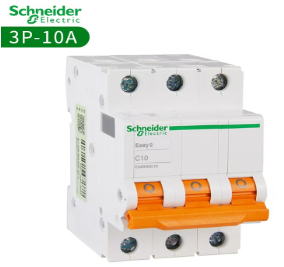Schneider Circuit Breakers
 The miniature circuit breakers (MCBs) of Schneider Electric are widely used in low-voltage power distribution systems with high reliability and advanced technology, especially providing precise overload and short-circuit protection in scenarios such as photovoltaic power grids. The following is a detailed description of its core products, technical characteristics, and procurement suggestions:
The miniature circuit breakers (MCBs) of Schneider Electric are widely used in low-voltage power distribution systems with high reliability and advanced technology, especially providing precise overload and short-circuit protection in scenarios such as photovoltaic power grids. The following is a detailed description of its core products, technical characteristics, and procurement suggestions:
I. Core Product Series and Technical Parameters
Schneider LRD Thermal Relay Price
1. **iC65 Series**
- **Interrupting Capacity**: Type N (6kA), Type H (10kA), Type L (15kA), meeting different short-circuit current requirements.
- **Tripping Curve**: Type C (power distribution protection), Type D (power protection), supporting a rated current of 1-63A.
- **Pole Number Selection**: From 1P to 4P, compatible with single-phase and three-phase systems.
- **Certification**: Passed UL 489 (independent product certification), and models with UL 489B certification suitable for the DC side of photovoltaic systems (such as the iC65 DC series).
2. **Resi9 Series*Chint NXR series thermal overload relays price*
- **Home Use Scenarios**: Integrated leakage protection (30mA), modular design, and supports pre-installed accessories (such as the VE leakage module).
- **Safety Features**: Tunnel-type terminal blocks (IP20B protection), Visi-Safe contact position indication, improving installation convenience.
- **Environmental Adaptability**: The operating temperature range is from -30°C to +70°C, meeting the requirements of harsh environments.
3. **C65 Series**
- **Economical Choice**: Interrupting capacity of 6kA, supporting a current of 1-63A, suitable for residential and small commercial applications.
- **Extended Functions**: Optional auxiliary contacts (SD) and shunt trip coils (MX) can be configured to achieve remote control.
II. Key Characteristics for Photovoltaic Power Grid Applications
1. **DC System Compatibility**
- Schneider has launched the **iC65 DC series** specifically designed for photovoltaics, supporting a voltage of 1000V DC and an interrupting capacity of 10kA, in line with the UL 489B standard. CHINT contactor price
- Non-polar design (such as the PowerPacT T-Frame series), suitable for bidirectional current (such as charging and discharging of energy storage systems).
2. *Adaptability to High Temperature Environments**
- In photovoltaic systems, MCBs need to cope with extreme temperatures. Schneider products use high-temperature-resistant materials. For example, the iC65 series can still maintain stable performance at an ambient temperature of 40°C.CHINT surge protector price
- It is recommended to select a derated use. For example, when the ambient temperature exceeds 40°C, the rated current needs to be derated by 5% for every 10°C increase.
3. **Installation and Maintenance**
- **Modular Design**: Supports rail installation, and accessories (such as leakage modules) can be quickly plugged and unplugged, reducing construction time.
- **Life Test**: The mechanical life of the iC65 series reaches 20,000 times, and the electrical life is 5,000 times, reducing maintenance costs.
III. Procurement and Supplier Suggestions
1. **Local Channels in the United States**
- **Authorized Distributors**: Query local distributors through the [Schneider Electric official website] such as **Grainger**, **Mouser Electronics**, etc.
- **Online Platforms**: Amazon, Home Depot, etc. provide in-stock products, which are suitable for urgent procurement.
- **Local Suppliers in Los Angeles**: Such as **Grover Electric & Plumbing Supply**, which can provide fast logistics.
2. **Model Selection Precautions**
- **Current Matching**: Select the interrupting capacity according to the short-circuit current of the photovoltaic array (for example, for a 1000V DC system, it is recommended to be ≥10kA).
- **Certification Requirements**: The DC side requires UL 489B certification, and the AC side requires UL 489 certification.
- **Accessory Requirements**: If leakage protection is required, select a model with a VE module (such as iC65N-C20A/2P+VE+30mA).
3. **Comparison with Chint**
- **Price**: The price of the Schneider iC65 series is usually 30%-40% higher than that of the Chint NXB series, but it has better interrupting capacity and longer service life.
- **Technology**: Schneider supports a wider temperature range (-30°C to +70°C), while some Chint models have a range of -5°C to +40°C.
- **Certification**: The Schneider iC65 DC has passed the UL 489B, and it is necessary to confirm whether Chint's similar products meet the North American standards.
IV. Typical Application Cases
- **Photovoltaic DC Combiner Box**: Use iC65 DC 1000V 32A (C curve) to protect against series string short circuits.
- **Energy Storage System**: PowerPacT T-Frame DC circuit breakers (such as T100H) support bidirectional current, with an interrupting capacity of 50kA.
- **Commercial Buildings**: The Resi9 series integrates leakage protection and is used for the protection of the AC side of rooftop photovoltaic systems.
V. Technical Documents and Support
- **Model Selection Tool**: Use the [Schneider Electric Selector software] to input parameters and automatically recommend models.
- **Installation Guide**: Refer to the "PowerPacT T-Frame Photovoltaic DC Circuit Breaker Installation Manual" (Document No. HRB80836).
- **After-sales Support**: Submit technical consultations through the Schneider official website, or contact local distributors to obtain FAE support.
If you need to further discuss specific project requirements or obtain a quotation, please contact via WhatsApp and provide the following information:
- System voltage (AC/DC), current rating
- Installation environment (indoor/outdoor, temperature range)
- Certification requirements (UL/CE, etc.)
- Accessory requirements (such as leakage, remote control)
With its technical advantages and global service network, Schneider Electric's MCB products can effectively ensure the safe operation of photovoltaic systems. It is recommended to give priority to models that have passed the UL 489B certification to meet the requirements of the North American market.


